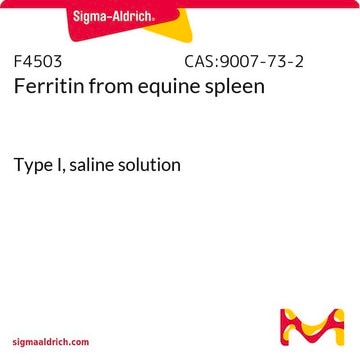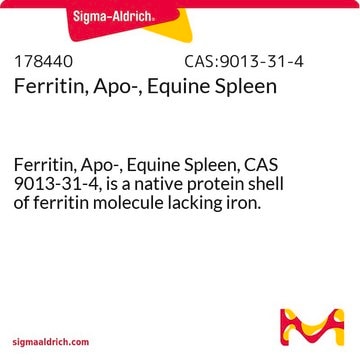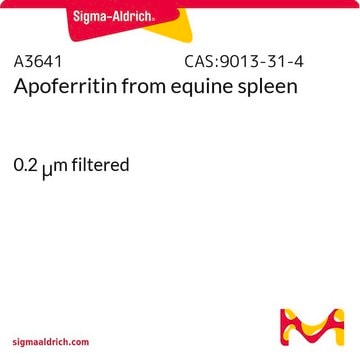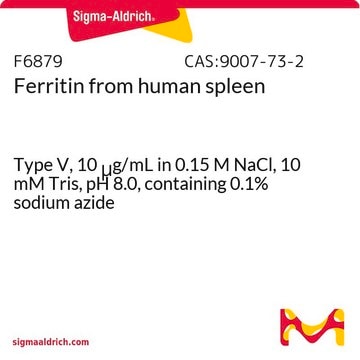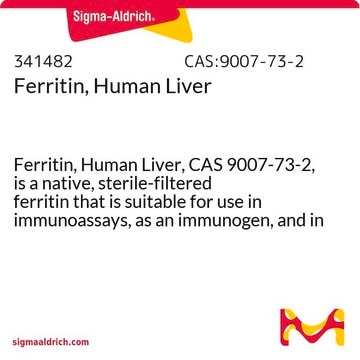F7879
Ferritin, cationized from horse spleen
10 mg/mL in 0.15 M NaCl
Autenticatiper visualizzare i prezzi riservati alla tua organizzazione & contrattuali
About This Item
Prodotti consigliati
Origine biologica
horse spleen
Livello qualitativo
Sterilità
sterile-filtered
Forma fisica
liquid
Concentrazione
10 mg/mL in 0.15 M NaCl
tecniche
cell culture | mammalian: suitable
electron microscopy: suitable
N° accesso UniProt
Temperatura di conservazione
2-8°C
Informazioni sul gene
horse ... FTL(100051593)
Descrizione generale
Ferritin, an iron-storage protein is usually present in the liver and spleen in mammals. Iron and ferritin are distributed relatively same in the eye. Ferritin is made up of heavy and light chains.
Applicazioni
A cationic derivative used to label negatively charged cell membranes for visualization by electron microscopy.
Ferritin is an iron storage protein that plays a central role in iron metabolism, and may be elevated in inflammatory or malignant diseases. It has been used in studies as an indicator of body iron supply, but may prove inaccurate in in the presence of chronic inflammation.
Ferritin, cationized from horse spleen has been used:
- to incubate amoebae (106) in the study, to determine whether trophozoites are able to take up ferritin and internalise this protein for their growth in axenic culture
- to determine phagosome-lysosome fusion by electron microscopy
- to label freshly excised chick optic tecta in serum free incubation medium
Azioni biochim/fisiol
Ferritin holds iron at its ferric state (Fe3+). The core of ferritin has the capability to hold 4500 iron molecules. It is essential to store iron in vertebrates. Ferritin is also essential to store and transport iron in invertebrates. It plays a key role in dietary iron absorption.
Nota sulla preparazione
Prepared by coupling horse spleen ferritin with N,N-dimethyl-1,3-propanediamine (DMPA).
Codice della classe di stoccaggio
10 - Combustible liquids
Classe di pericolosità dell'acqua (WGK)
WGK 2
Punto d’infiammabilità (°F)
Not applicable
Punto d’infiammabilità (°C)
Not applicable
Certificati d'analisi (COA)
Cerca il Certificati d'analisi (COA) digitando il numero di lotto/batch corrispondente. I numeri di lotto o di batch sono stampati sull'etichetta dei prodotti dopo la parola ‘Lotto’ o ‘Batch’.
Possiedi già questo prodotto?
I documenti relativi ai prodotti acquistati recentemente sono disponibili nell’Archivio dei documenti.
I clienti hanno visto anche
R H Adamson et al.
The Journal of physiology, 445, 473-486 (1992-01-01)
1. We have investigated the interaction of plasma proteins with the endothelial cell using cationized ferritin as a marker of the cell surface glycocalyx. 2. Single microvessels of the frog mesentery were sequentially perfused using glass micropipettes with solutions containing
Jennifer R Charlton et al.
American journal of physiology. Renal physiology, 321(3), F293-F304 (2021-07-21)
Kidney pathologies are often highly heterogeneous. To comprehensively understand kidney structure and pathology, it is critical to develop tools to map tissue microstructure in the context of the whole, intact organ. Magnetic resonance imaging (MRI) can provide a unique, three-dimensional
Interaction of Legionella pneumophila with Acanthamoeba castellanii: uptake by coiling phagocytosis and inhibition of phagosome-lysosome fusion.
Bozue J A and Johnson W
Infection and Immunity, 64(2), 668-673 (1996)
Fabrizio Bardelli et al.
Scientific reports, 7, 44862-44862 (2017-03-24)
Once penetrated into the lungs of exposed people, asbestos induces an in vivo biomineralisation process that leads to the formation of a ferruginous coating embedding the fibres. The ensemble of the fibre and the coating is referred to as asbestos
Jennifer R Charlton et al.
BMC nephrology, 24(1), 178-178 (2023-06-19)
A significant barrier to biomarker development in the field of acute kidney injury (AKI) is the use of kidney function to identify candidates. Progress in imaging technology makes it possible to detect early structural changes prior to a decline in
Il team dei nostri ricercatori vanta grande esperienza in tutte le aree della ricerca quali Life Science, scienza dei materiali, sintesi chimica, cromatografia, discipline analitiche, ecc..
Contatta l'Assistenza Tecnica.